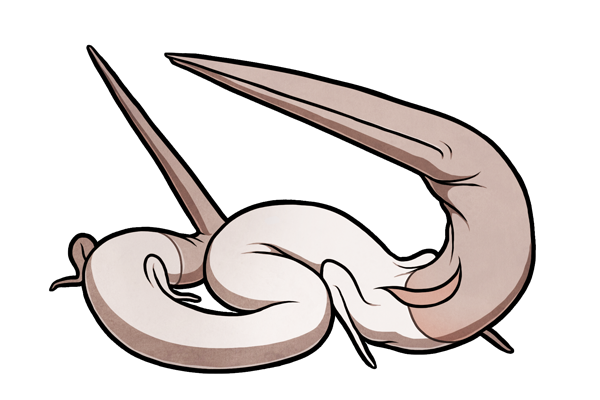

pavlodrine
the tritowers
prefix pavlo suffix drine
gerogravi pandou
physical appearance
The pavlodrine /ˈpævlədɹiːn/ is a dull-colored stranger with a stiff, elongated head and tail. It possesses a rough, dry exterior, is dusty and foamy inside, but not without moisture, though no more than a cup's worth of water can be expressed from the entirety of the pavlodrine's form.
The pavlodrine's insides, once exposed to air, dry up, which is fatal to the stranger. Any puncture can deflate the pavlodrine eventually, although small wounds will scab if given enough time (with these scabs being white and rough, crumbling if picked at). Though normally fleshy, the pavlodrine shatters like porcelain if struck. When broken like this, its flesh becomes "ceramic" and it does not decay on its own.
Here, come around the side, and hold it.

environment and generation
The pavlodrine appears in a wide range of abandoned environments. It prefers a scattered overgrowth of foliage, old posters held onto cement, crumbled divisions between floors and buildings, windows that do little to separate a space from the outside world, and layers of paint that crack and peel like tree bark.
Within these spaces, it grows from a small, neotenic form, which is only able to wriggle as it grows, and becomes mobile upon reaching full size.
behaviour and effects
The pavlodrine's disposition is prudent, its motions functional, but lacking the grace suggested by its elongated form. Within its small territory, it is most drawn towards high walls, dead branches that reach into rooms, and overhanging cables, which it touches with its head. Its head it holds upwards along with its tail, balancing uneasily at times but never loosing its footing despite its thin legs. It either travels in small loops, or remains in place.
It does not tend to readily display the more subtle aspects of its behaviour, instead presenting these actions with irregularity as time passes.
Though not forming any lasting bonds, the pavlodrine approaches its kin, with each individual placing their head upon the other's back or shoulder. The pavlodrine's movements become more slight and careful when in proximity to another of its strain, any physical contact causing the gentle sound of paper-against-paper as their skin rubs slightly together.
It rests its chest on clasped hands, where a breastbone would be.
interactions with sensitives
The pavlodrine does not disrupt its overall behaviour in the presence of sensitives, but does tend to move away from them, and never towards. When able, it slips through door-frames and out of sight, maintaining this slow saunter without pause.
If rubbed in a counter-clockwise, circular manner, the pavlodrine causes a low-level vibrating sensation that hums through the muscles and out the skin. This oscillation persists for ten to fifteen minutes before dropping off abruptly in intensity.
Its feet are often still.
It stretches.

left to right: entaut, enbroached, enjoined
Depending on the alignment of its head, and how close the head is to the tail, the pavlodrine changes the way that sound is perceived. When these two poles are aligned in certain ways, it will distort audio in ways that can make any verbal communication impossible.

left to right: "levened" (forward), "uncrossed bows", "adjudicant"
When attacked, the pavlodrine grows aggressive, if clumsy, swinging its heavy head and tail, its blows capable of downing all but the most robust sensitive. Once violence towards it ceases, however, the pavlodrine grows evasive once more. As it is also broken to hard plates if struck with enough force, the pavlodrine cannot be seen as a threat to any sensitive's wellbeing.
response to birdsong
The pavlodrine displays a specific response to birdsong. The more birdsong it is exposed to, the more this starts to overwhelm it and must be 'purged' outwards via the production of audio. Exposure to one minute of birdsong means that the pavlodrine must repeat this birdsong for ten minutes at a later point, lest it develop a scattering of neurotic tics; exposure to ten minutes requires 100 minutes of repetition, and so on. Even unrelated audio that sounds similar to birdsong (such as a chirping electronic device, or squeaking hinge) cause a slight amount of interference as well, although to a lesser extent. Certain pavlodrine become more proficient in cleansing themselves these sounds, however, lessening the time required by doubling or quadrupling the amount of audio that they produce, creating complex patterns and harmonies𐑸 in the process. Other pavlodrine position their head and tail to distort these sounds beyond recognition, with less stable individuals being more likely to become averse to the sound of birdsong itself.
𐑸 It imitates not just birdsong, but an orchestra of birdsong, sound in stereo.
It idly presses its hands to its neck when alone.
aging and death
Towards the end of its life, the pavlodrine aligns its head and tail with the earth's magnetic poles, and travels in a southwest direction. It exhibits the physical signs of aging only after beginning this journey, with its skin and flesh softening and cracking as it travels at a rate of one to four miles per day. It becomes steadfast in this voyage, crawling when it can no longer walk, and dragging itself forward as its limbs weaken one by one. It reaches no ultimate destination, instead dying and collapsing with a slump. Its corpse rots as would meat, its foul-smelling flesh attracting some insects and mammals, but never scavenging birds.



